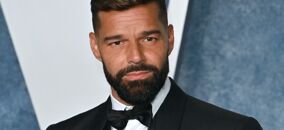The following is an excerpt from the new book, Splice of Life: A Memoir in 13 Film Genres, out now. It’s a compelling and unconventional memoir from queer writer, film aficionado, and former Jeopardy! contestant Charles Jensen.
Charles has upcoming readings at Changing Hands Bookstore in Phoenix on June 14, the Long Beach Public Library on June 20, and The Booksmith in San Francisco on July 11.

POSTMODERN PASTICHE
JANUARY 1997
Your dose of fabulosi-TEA
Subscribe to our newsletter for your front-row seat to all things entertainment with a sprinkle of everything else queer.
Sexual Health Awareness and Disease Education (SHADE) was housed in the School of Public Health and led by Dave, a tall guy with wild graying hair who radiated positivity and support.
At my friend Lori’s encouragement, I received special permission to join the group in the second quarter even though I had not taken the required public health course on STIs. I learned the scripts for various presentations we gave on campus and in the community, teaching consent, good sexual health practices, and providing the most up-to-date information to other students.
The AIDS pandemic continued to ravage the gay community in the mid-90s, but infections had moved into the general population. This stoked and deepened anti-gay sentiments and anti-gay violence across the United States. My high school health class had mentioned AIDS exactly once when my teacher told us, “If you have gay sex, you will get AIDS and die.”
It was difficult in those years for someone to disclose their HIV status. The stigma was too strong. There was too much at stake. They could be fired, they could lose their housing—any number of devastating actions could be taken against them, but disclosure meant facing stigma from within the queer community as well.
As a public health crisis, those fighting to stop the spread of AIDS took drastic measures to change sexual behavior, sometimes seeming to echo the words of my health teacher. The Red Cross banned sexually active gay men from giving blood, a prohibition that continued without exception until 2023, even when there was so much more reliable information about transmission, detectability, treatment, and prevention.
For me, and for some members of my microgeneration of gay men who came out after the crisis began but before accurate information was widely available, AIDS was terrifying. We knew of thousands of men who died slow, difficult deaths in the 80s and 90s. I did not want to be among them. When I came out to my parents, they told me they were afraid I would die of the disease. Many other gay men heard the same thing.
Layered beneath these fears were my own deep-seated issues about sex and sexuality. I wanted to have sex, but I had a weird Puritan streak in my brain about it. Walking through a gay bar and feeling someone grab my ass or slide a hand down my back made me uncomfortable.
If I complained, I was told to “lighten up” and “enjoy it.” Even by my own friends. Worse, I didn’t feel a connection to my own body. Insecurities plagued my brain. All of it made me feel even more isolated in the soup of my conflicted feelings.
Members of SHADE marched in the Homecoming Parade the next year, and I wore the comical full-body condom costume for the event: a long, gauzy tube with a cut out for my face and a rubber hat shaped like a receptacle tip.
SHADE undid some of the shame and discomfort I felt around sexuality. I was forced to talk about it, publicly, and to help people make safer choices. By extension, I took better responsibility for myself. It would be more than a decade before I felt fully connected to my own sexuality, my own body, my own desires, but all of that work started here, with a gesture toward learning to talk frankly and openly about sex.

EYES WITHOUT A FACE
Billy is the moody, over-sensitive boy who doesn’t say much—his social dysfunction is charitably interpreted as normal masculinity. He exudes a dangerous kind of confidence throughout the film—a toxic masculinity—whether he’s crawling up into Sidney’s second-floor bedroom or, you know, murdering classmates.
Ghostface—the black-clad killer with a mask inspired by Munch’s tormented figure in The Scream—calls Sidney up to ask her what’s her favorite scary movie, but she laughs it off. “What’s the point? They’re all the same. Some stupid killer stalking some big-breasted girl who can’t act who is always running up the stairs when she should be running out the front door.”
Sidney’s indictment of the genre’s heroines almost immediately comes back to haunt her when Ghostface appears at her house. Sidney—against her own advice—runs up the stairs to her bedroom, where the doors to her bedroom and her closet nest in such a way that neither can be fully opened. Despite her haughty hot take on horror movie heroines, she’s no different in the heat of the moment.
Billy crawls through her window a second time—a horribly-timed romantic gesture that scares her. But when a cell phone drops out of his pocket, Sidney leaps to suspect Billy of being the killer. More than that, she trusts in her own belief. She gets him arrested, and continues to avoid him once he’s been released.
When Sidney later goes to the party at Stu’s (Matthew Lillard) house, Billy shows up against her wishes. “Dude,” Stu says, winking at Billy. “What are you doing here?” The wink is a double-edged gesture: it means both “we’re in cahoots” and “I’m flirting with you.” Here, knowing what we know by the end of the film, this wink is among the most meaning-laden winks of all time.
OCTOBER 1996
Dance music thumped through the door of the house, the windows chattering like teeth. The queer fraternity was an anchor of the queer social scene. Though I wasn’t a member, I was a fan of their parties.
Their house stood at the end of fraternity row, tucked around a corner as if seeking just a bit more privacy than the other houses, as if they were more modest, more conservative. Inside the house, where the couches and side tables crouched along the walls and the spinning strobes and colored lights flashed while insistent beats played, the opposite was true.
Everyone was more themselves there, as though passing through the threshold meant taking off or putting on one’s public costume. I loved these parties in part because it was easy to get booze, and booze quieted my anxieties and insecurities. I feared and hated myself less when I was drunk.
My queerness felt like a train passing me in the night, cars I could look into as the windows flashed by, but something I didn’t occupy. Something that wasn’t carrying me. I was afraid of having sex and I was afraid of never having sex. Afraid of being left alone and of being fully myself.
I stood against the wall in the basement of the campus’s gay fraternity, near the bar, nursing my cup of party punch and trying not to make eye contact with anyone, even as I gazed with longing at any number of men who passed by me. What did I want? To be seen, touched, loved. But not acknowledged, understood, known.
My friend Karen walked up and introduced me to a man I’d never seen before. He had short dark hair with bangs swept away from his face, five o’clock shadow working overtime. He had a kind face. He was older—mid-twenties maybe. He wasn’t in school. Karen hovered for a few minutes but then excused herself to let us talk.
I don’t remember what the man and I talked about, but I know he asked me if I wanted to go home with him. I was outside my body talking to him. I heard myself say, Sure. I was drunk, or drunk enough, which was my goal. In the car to his place, it took five minutes for me to lose our location. I vanished into the city with him. I was nineteen.
I fumbled out of my clothes at his apartment. I kissed him. I felt his body over me. He asked if he could fuck me but I demurred. Then he fell asleep.
In the morning, he offered me breakfast. I said no. I wanted to go home. Was I sure? He could whip something up, or we could go out.
No, I said. I pulled myself into my coat to armor me. He tried to make conversation on the way home, but I couldn’t. I must have seemed like a miserable person. He dropped me at the door of my dorm and I never saw him again.
“Good thing he didn’t murder you,” a friend said at breakfast when I told her what had happened. She was half-joking. I hadn’t considered my safety in all this—a privilege of being born white and male. The next summer, a young gay man launched a killing spree from Minneapolis, traveling down the continent to Miami where he shot Versace on the front steps of his mansion. I watched it unfold on the news. I considered myself, somehow, lucky.

JUNE 1999
My senior project on Scream was an earnest attempt to make sense of the film’s metaphors and insinuations. Horror and thriller genres up until that time were notoriously and often straightforwardly homophobic and transphobic—from Anthony Perkins’s mother-loving motelier in Psycho to the cross-dressing killer of Dressed to Kill to the possibly trans identified killer of The Silence of the Lambs. Even A Nightmare on Elm Street’s Freddy Krueger, a child-killer, can be viewed as queer coded (and without argument in the homoerotic A Nightmare on Elm Street 2), as he was developed in an era when homosexual men were generally feared by straight people to be violent pedophiles.
Though I enjoyed Scream a great deal and, as a fan of horror films, wanted it to be taken seriously, I was troubled as a queer viewer. Was the film suggesting something about homosexuality?
I wanted the presentation to offer evidence. Here’s what my classmates heard as the video played:
Billy: (to Sidney) Watch this. (to Stu) Are you ready?
Stu: Yeah. Yeah. I’m ready baby. Hit it! Get it up! Get up! Hit it!
*stabbing sound*
Stu whimpers. Then: Jesus, man. Oh, shit. My turn.
Billy: Don’t forget. Stay to the side and don’t go too deep.
Stu: Okay, I’ll remember.
Billy: Ah, fuck! Fuck! God damn it, Stu.
Stu: Sorry, Billy. I guess I got a little too zealous, huh?
Billy: Gimme the knife.
Stu: No.
Billy: Give me the knife. Now!
Stu: You see, Sidney, everybody dies but us. Everybody dies but us. We’re gonna carry on and plan the sequel because let’s face it baby, these days you have to have a sequel.
Sidney: You sick fucks. You’ve seen too many movies.
Stu: Don’t you blame the movies. Movies don’t make psychos, movies make psychos more creative.
*sounds of the knife puncturing flesh, scraping bone*
Stu: Stop it, Billy, I can’t take anymore. I’m feeling woozy.
With the television turned around, the images hidden from my classmates and professor, the scene sounded like gay porn. Like Billy and Stu were taking turns fucking each other.
And, with the knife standing in for the metaphorical dicks they couldn’t shove into each other, they kind of were.
Splice of Life: A Memoir in 13 Film Genres by Charles Jensen is available now wherever books are sold. Reprinted with permission.
Don’t miss Charles at Changing Hands Bookstore in Phoenix on June 14, the Long Beach Public Library on June 20, and The Booksmith in San Francisco on July 11.
Related*


All the hidden (and not so hidden) gay culture happening within the ‘Scream’ universe
In honor of the new “Scream” hitting theaters this week, we’ve decided to take a look back at the first four films and make note of all the hidden (and not so hidden) LGBTQ gems found within the “Scream” universe.
Don't forget to share:














































